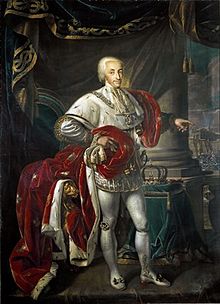Victor Emmanuel I
| Victor Emmanuel I | |||||
|---|---|---|---|---|---|

Victor Emanuel I in Coronation Robes
|
|||||
| King of Sardinia and Duke of Savoy | |||||
| Reign | 4 June 1802 – 12 March 1821 | ||||
| Predecessor | Charles Emmanuel IV | ||||
| Successor | Charles Felix | ||||
| Born |
24 July 1759 Royal Palace of Turin, Turin, Kingdom of Sardinia |
||||
| Died | 10 January 1824 (aged 64) Castle of Moncalieri, Turin, Kingdom of Sardinia |
||||
| Burial | Basilica of Superga, Turin | ||||
| Consort | Maria Teresa of Austria-Este | ||||
| Issue among others... |
Maria Beatrice, Duchess of Modena Maria Teresa, Duchess of Parma Maria Anna, Empress of Austria Maria Christina, Queen of the Two Sicilies |
||||
|
|||||
| House | House of Savoy | ||||
| Father | Victor Amadeus III of Sardinia | ||||
| Mother | Maria Antonia Ferdinanda of Spain | ||||
| Religion | Roman Catholicism | ||||
| Full name | |
|---|---|
| Vittorio Emanuele di Savoia |
Victor Emmanuel I (Vittorio Emanuele; 24 July 1759 – 10 January 1824) was the Duke of Savoy and King of Sardinia (1802–1821).
Victor Emmanuel was the second son of King Victor Amadeus III of Sardinia and Maria Antonia Ferdinanda of Spain, daughter of King Philip V of Spain and Elisabeth Farnese.
Victor Emmanuel was known from birth as the Duke of Aosta. From 1792 to 1796, Aosta's father had taken an active part in the struggle of the old powers against the revolutionary forces in France but was defeated and forced to make peace, signing the Traty of Paris. The old king died shortly thereafter, and in December 1798, his eldest son and successor, Charles Emmanuel IV, was faced with a French occupation and eventually annexation, of his mainland territories.
Charles Emmanuel and his family were forced to withdraw to Sardinia, which was the only part of his domains not conquered by the French. Charles Emmanuel himself took little interest in the rule of Sardinia, living with his wife on the mainland in Naples and Rome until his wife's death in 1802, which led the childless Charles Emmanuel to abdicate the throne for of his younger brother.
Aosta took the throne on 4 June 1802 as Victor Emmanuel I. He ruled Sardinia from Cagliari for the next twelve years, during which time he constituted the Carabinieri, a Gendarmerie corps, still existing as one of the main branches of the military of Italy.
Victor Emmanuel could return to Turin only in 1814, his realm reconstituted by the Congress of Vienna, with the addition of the territories of the former Republic of Genoa. The latter became the seat of the Sardinian Navy. Victor Emmanuel abolished all the freedoms granted by the Napoleonic Codices and restored a fiercely oppressive rule: he restored the Regie Costituzioni of Victor Amadeus II and the Jus commune, strengthened customs barriers, refused to grant a liberal constitution, entrusted education to the Church and reintroduced laws concerning labour and the justice system which discriminated against Jews and Waldensians.
...
Wikipedia
